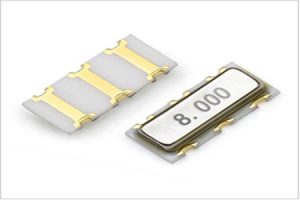Unlocking the mystery of Thermistor crystal oscillator
Are you interested to know about Thermistor crystal oscillators?
A thermistor and a quartz crystal are used in a thermistor crystal oscillator to provide a steady frequency signal. A resistor type known as a thermistor has a resistance that changes with temperature. The oscillator can adjust for temperature variations that impact the quartz crystal’s frequency by pairing a thermistor with a resonator. A voltage is applied to the quartz crystal as part of the oscillator circuit to force it to vibrate at a particular frequency. The size and form of the crystal affect the vibration frequency. Because the thermistor and crystal are linked in series, temperature changes also result in changes in the thermistor’s resistance, which affects the oscillator’s frequency. The feedback loop, composed of the thermistor and the crystal, compensates for the frequency shift, keeping the output frequency constant despite temperature variations. Thermostats and other temperature-sensitive devices, such as temperature sensors, frequently employ thermistor crystal oscillator. They are also utilized in digital circuits that need a reliable and precise clock signal.
Find Out More About the Advantages of Employing a Thermistor Crystal Oscillator:
With good temperature correction, low power consumption, and high-quality output, these crystal oscillators provide a stable, dependable, and precise timing solution. They are extensively employed in many fields, including communication systems, automobiles, aeroplanes, and medical equipment. Using a thermistor crystal oscillator has several advantages, including:
- Stability:
A thermistor and quartz crystal combination offer good frequency stability over a wide temperature range. This is crucial in situations that call for precise timing or frequency control.
- Temperature Compensation:
The oscillator’s thermistor automatically adjusts the oscillator’s temperature. Temperature-dependent changes in the thermistor’s resistance cancel out changes in frequency brought on by temperature fluctuations in the crystal oscillator.
- Low power consumption:
These crystal oscillators have a low power consumption, which makes them perfect for battery-powered applications.
- High-quality Output:
A crystal oscillator produces a completely undistorted sine wave. This is crucial for applications that demand high-quality signals.
- Long Life:
These crystal oscillators are extremely dependable and have a long operational life. They are utilized in crucial applications where failure is not an option, including aviation and medical equipment.
- Small Size:
These crystal oscillators come in compact package sizes, making them perfect for limited space.
In which fields is a thermistor crystal oscillator used?
This combination makes many applications possible, including temperature measurement, remote sensing, frequency control, and even timing in medical equipment. A thermistor crystal oscillator is suited for a wide range of applications since they are offered in various package sizes and frequencies. They are employed in systems for the automotive, medical, and aerospace industries as well as in telecommunications, digital electronics, and many other fields where accurate timing or frequency control is essential.

Engineers must be familiar with the operation of thermistor crystal oscillators to select the ideal oscillator for their particular application. This is how it goes:
- To produce a steady frequency signal, thermistor crystal oscillators pair a quartz crystal resonator with a thermistor. The frequency-determining component is a quartz crystal, and the temperature correction component is a thermistor. A feedback loop in the oscillator circuit modifies the oscillator frequency in response to variations in temperature that impact the thermistor resistance. This feedback loop ensures that the oscillator output stays steady regardless of temperature fluctuations.
- The quartz crystal vibrates when a voltage is applied at a particular frequency dictated by its size and form. The thermistor, which is linked in series with the crystal, adjusts its resistance in response to variations in temperature. The oscillator’s output frequency is measured and compared to a reference frequency in the feedback loop, which modifies the oscillator’s frequency to maintain the correct output frequency.
- The package size, frequency range, and power consumption of a thermistor crystal oscillatorare all things to consider when selecting one for a particular application. The precision, stability, and dependability of the oscillator in the application’s working environment should also be considered by engineers.
How do Thermistor Crystal Oscillators function?
In conjunction, the thermistor and quartz crystal offers exceptional frequency stability across a broad temperature range. The thermistor compensates for temperature fluctuations that affect the oscillator frequency. Thermistor crystal oscillators are hence perfect for applications requiring precision timing or frequency control over a wide temperature range. A quartz crystal and thermistor are used in thermistor crystal oscillators to provide a steady frequency output. Here’s how it operates:
- A thin quartz material slice with a particular size and form makes up the quartz crystal resonator. The crystal starts to vibrate at a frequency known as its resonance frequency when a voltage is put across it. The crystal’s size and shape affect its resonance frequency.
- The quartz crystal resonator is closely linked with the temperature-sensitive resistor thermistor. Thermistor resistance varies with temperature; the oscillator uses this variation to compensate for temperature.
- A feedback loop built into the oscillator circuit measures the oscillator’s output frequency and compares it to a reference frequency. The feedback loop modifies the oscillator frequency to maintain the required output frequency.
- The thermistor’s resistance varies with temperature, which alters the oscillator’s frequency. The feedback loop adjusts the oscillator frequency to account for temperature changes based on measurements of the frequency variation.
Conclusion:
A thermistor crystal oscillator combines a quartz crystal resonator with a thermistor for temperature correction to provide a consistent frequency signal. The oscillator circuit has a feedback loop that modifies the oscillator frequency in response to temperature changes, preserving the output frequency despite temperature changes. Our business has always sought to increase the value of our customers by offering a full range of solutions for various frequency control components, components, and modular design needs to satisfy all of their requirements. ChipSun Technology has consistently surpassed customers’ expectations regarding price, quality, delivery, and other factors.
